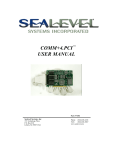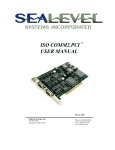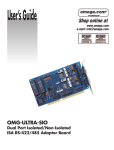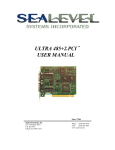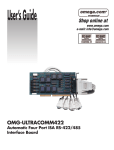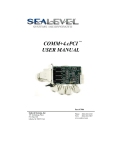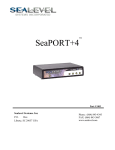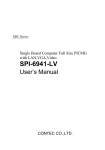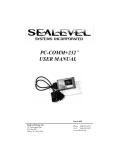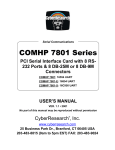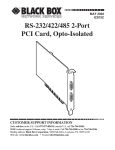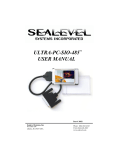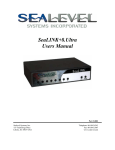Download ULTRA COMM+422.PCI USER MANUAL
Transcript
ULTRA COMM+422.PCI USER MANUAL TM Part # 7402 Sealevel Systems, Inc 155 Technology Place P.O. Box 830 Liberty, SC 29657 USA Phone: (864) 843-4343 FAX: (864) 843-3067 www.sealevel.com Contents INTRODUCTION ........................................................................ 1 OVERVIEW ...........................................................................................1 WHAT’S INCLUDED..............................................................................1 FACTORY DEFAULT SETTINGS..............................................................1 CARD SETUP............................................................................. 2 RS-485 ENABLE MODES.....................................................................2 Interface Mode Examples J1B –J4B (continued) .......................4 ADDRESS AND IRQ SELECTION.............................................................4 LINE TERMINATION..............................................................................5 BAUD RATES AND DIVISORS FOR THE ‘DIV1’ MODE...........................7 BAUD RATES AND DIVISORS FOR THE ‘DIV2’ MODE...........................8 INSTALLATION.......................................................................... 9 OPERATING SYSTEM INSTALLATION ....................................................9 For Windows Users .......................................................................9 Other Operating Systems ..............................................................9 SYSTEM INSTALLATION .......................................................................9 TECHNICAL DESCRIPTION ..................................................... 10 Interrupts.......................................................................................10 WHY USE AN ISP? .............................................................................11 CONNECTOR P IN ASSIGNMENTS .........................................................12 RS-422/485 (DB 9 Male) ........................................................12 DB-37 Connector Pin Assignments...........................................12 SPECIFICATIONS ..................................................................... 13 ENVIRONMENTAL SPECIFICATIONS.....................................................13 MANUFACTURING..............................................................................13 P OWER CONSUMPTION ......................................................................13 MEAN TIME BETWEEN FAILURES (MTBF) ........................................13 P HYSICAL DIMENSIONS......................................................................13 APPENDIX A - TROUBLESHOOTING ....................................... 14 PCI COM NUMBER SELECTION IN WINDOWS 95/98 .........15 APPENDIX B - HOW TO GET ASSISTANCEERROR! BOOKMARK NOT DEFINED. APPENDIX C - ELECTRICAL INTERFACE ................................ 17 RS-422.............................................................................................17 RS-485.............................................................................................17 APPENDIX D - ASYNCHRONOUS COMMUNICATIONS ............ 18 APPENDIX E - SILK-SCREEN .................................................. 19 APPENDIX F - COMPLIANCE NOTICES ................................... 20 FEDERAL COMMUNICATIONS COMMISSION STATEMENT ...................20 EMC DIRECTIVE STATEMENT ...........................................................20 WARRANTY ........................ERROR! BOOKMARK NOT DEFINED. Figures Figure 1- Headers J1B – J4B, RS-422............................................................ 3 Figure 2 - Headers J1B – J4B, RS-485 ‘Auto’ Enabled, with ‘No Echo’ ..... 3 Figure 3 - Headers J1B – J4B, RS-485 ‘Auto’ Enabled, with ‘Echo’ ........... 3 Figure 4 - Headers J1B – J4B, RS-485 ‘RTS’ Enabled, with ‘No Echo’ ..... 4 Figure 5 - Headers J1B – J4B, RS-485 ‘RTS’ Enabled, with ‘Echo’ ........... 4 Figure 6 - Headers J1A – J4A, Line Termination.......................................... 5 Figure 7 - Clocking Mode 'Divide By 4’ ......................................................... 6 Figure 8 - Clocking Mode 'Divide By 2’ ......................................................... 6 Figure 9 - Asynchronous Communications Bit Diagram............................... 18 © 2001d Sealevel Systems, Incorporated. All rights reserved. Introduction Introduction Overview The Sealevel ULTRA COMM+422.PCI is a four channel PCI Bus serial I/O adapter for the PC and compatibles supporting data rates up to 460.8K bps. RS-422 provides excellent communications for long distance device connections up to 4000ft., where noise immunity and high data integrity are essential. Select RS-485 and capture data from multiple peripherals in a RS-485 multidrop network. In both RS-485 and RS-422 modes, the card works seamlessly with the standard operating system serial driver. In RS-485 mode, our special autoenable feature allows the RS-485 ports to be viewed by the operating system as a COM: port. This allows the standard COM: driver to be utilized for RS-485 communications. Our on-board hardware automatically handles the RS-485 driver enable What’s Included The ULTRA COMM+422.PCI is shipped with the following items. If any of these items are missing or damaged, contact the supplier. • • • ULTRA COMM+422.PCI Serial I/O Adapter Sealevel Software “Spider” Cable providing 4 DB-9 connectors Factory Default Settings The ULTRA COMM+422.PCI factory default settings are as follows: Port # Port 1 Port 2 Port 3 Port 4 Clock DIV Mode 4 4 4 4 Enable Mode Auto Auto Auto Auto To install the ULTRA COMM+422.PCI using factory default settings, refer to Installation on page 9. For your reference, record installed ULTRA COMM+422.PCI settings below: Port # Clock DIV Mode Enable Mode Port 1 Port 2 Port 3 Port 4 Sealevel Systems ULTRA COMM+422.PCI Page 1 Card Setup Card Setup In all cases J1x is for port 1, J2x - port 2, J3x - port 3 and J4x – port 4. RS-485 Enable Modes RS-485 is ideal for multi-drop or network environments. RS-485 requires a tri-state driver that will allow the electrical presence of the driver to be removed from the line. The driver is in a tri-state or high impedance condition when this occurs. Only one driver may be active at a time and the other driver(s) must be tri-stated. The output modem control signal Request To Send (RTS) is typically used to control the state of the driver. Some communication software packages refer to RS-485 as RTS enable or RTS block mode transfer. One of the unique features of the ULTRA COMM+422.PCI is the ability to be RS-485 compatible without the need for special software or drivers. This ability is especially useful in Windows, Windows NT, and OS/2 environments where the lower level I/O control is abstracted from the application program. This ability means that the user can effectively use the ULTRA COMM+422.PCI in an RS-485 application with existing (i.e. standard RS-232) software drivers. Headers J1B – J4B are used to control the RS-485 mode functions for the driver circuit. The selections are ‘RTS’ enable (silk-screen ‘RT’) or ‘Auto’ enable (silk-screen ‘AT’). The ‘Auto’ enable feature automatically enables/disables the RS-485 interface. The ‘RTS’ mode uses the ‘RTS’ modem control signal to enable the RS-485 interface and provides backward compatibility with existing software products. Position 3 (silk-screen ‘NE’) of J1B – J4B is used to control the RS-485 enable/disable functions for the receiver circuit and determine the state of the RS-422/485 driver. The RS-485 ‘Echo’ is the result of connecting the receiver inputs to the transmitter outputs. Every time a character is transmitted; it is also received. This can be beneficial if the software can handle echoing (i.e. using received characters to throttle the transmitter) or it can confuse the system if the software does not. To select the ‘No Echo’ mode select silk-screen position ‘NE’. For RS-422/530/449 compatibility remove the jumpers at J1B – J4B. Examples on the following pages describe all of the valid settings for J1B – J4B. Sealevel Systems ULTRA COMM+422.PCI Page 2 Card Setup AT RT NE Interface Mode Examples J1B – J4B AT RT NE Figure 1- Headers J1B – J4B, RS-422 AT RT NE Figure 2 - Headers J1B – J4B, RS-485 ‘Auto’ Enabled, with ‘No Echo’ Figure 3 - Headers J1B – J4B, RS-485 ‘Auto’ Enabled, with ‘Echo’ Sealevel Systems ULTRA COMM+422.PCI Page 3 Card Setup AT RT NE Interface Mode Examples J1B –J4B (continued) AT RT NE Figure 4 - Headers J1B – J4B, RS-485 ‘RTS’ Enabled, with ‘No Echo’ Figure 5 - Headers J1B – J4B, RS-485 ‘RTS’ Enabled, with ‘Echo’ Address and IRQ selection The ULTRA COMM+422.PCI is automatically assigned I/O addresses and IRQs by your motherboard BIOS. Only the I/O addresses may be modified by the user. Adding or removing other hardware may change the assignment of I/O addresses and IRQs. Sealevel Systems ULTRA COMM+422.PCI Page 4 Card Setup Line Termination Typically, each end of the RS-485 bus must have line terminating resistors (RS-422 terminates the receive end only). A 120-ohm resistor is across each RS-530/422/485 input in addition to a 1K ohm pull-up/pull-down combination that biases the receiver inputs. Headers J1A – J4A allow the user to customize this interface to their specific requirements. Each jumper position corresponds to a specific portion of the interface. If multiple ULTRA COMM+422.PCI adapters are configured in an RS-485 network, only the boards on each end should have jumpers T, P & P ON. Refer to the following table for each position’s operation: Name P P T L L Function Adds or removes the 1K ohm pull-down resistor in the RS-422/RS-485 receiver circuit (Receive data only). Adds or removes the 1K ohm pull-up resistor in the RS-422/RS-485 receiver circuit (Receive data only). Adds or removes the 120 ohm termination. Connects the TX+ to RX+ for RS-485 two wire operation. Connects the TX- to RX- for RS-485 two wire operation. P P T L L Figure 6 - Headers J1A – J4A, Line Termination Sealevel Systems ULTRA COMM+422.PCI Page 5 Card Setup Clock Modes The ULTRA COMM+422.PCI employs a unique clocking option that allows the end user to select from divide by 4, divide by 2 and divide by 1 clocking modes. These modes are selected at Headers J1C through J4C. DIV1 DIV2 DIV4 To select the Baud rates commonly associated with COM: ports (i.e. 2400, 4800, 9600, 19.2, … 115.2K Bps) place the jumper in the divide by 4 mode (silk-screen DIV4). Figure 7 - Clocking Mode 'Divide By 4’ DIV1 DIV2 DIV4 To double these rates up to a maximum rate for 230.4K bps place the jumper in the divide by 2 (silk-screen DIV2) position. Figure 8 - Clocking Mode 'Divide By 2’ Sealevel Systems ULTRA COMM+422.PCI Page 6 Card Setup Baud Rates and Divisors for the ‘DIV1’ mode The following table shows some common data rates and the rates you should choose to match them if using the adapter in the ‘DIV1’ mode. For this Data Rate 1200 bps 2400 bps 4800 bps 9600 bps 19.2K bps 57.6 K bps 115.2 K bps 230.4K bps 460.8K bps Choose this Data Rate 300 bps 600 bps 1200 bps 2400 bps 4800 bps 14.4K bps 28.8K bps 57.6 K bps 115.2 K bps If your communications package allows the use of Baud rate divisors, choose the appropriate divisor from the following table: For this Data Rate 1200 bps 2400 bps 4800 bps 9600 bps 19.2K bps 38.4K bps 57.6K bps 115.2K bps 230.4K bps 460.8K bps Sealevel Systems ULTRA COMM+422.PCI Choose this Divisor 384 192 96 48 24 12 8 4 2 1 Page 7 Card Setup Baud Rates and Divisors for the ‘DIV2’ mode The following table shows some common data rates and the rates you should choose to match them if using the adapter in the ‘DIV2’ mode. For this Data Rate 1200 bps 2400 bps 4800 bps 9600 bps 19.2K bps 38.4K bps 57.6 K bps 115.2 K bps 230.4 K bps Choose this Data Rate 600 bps 1200 bps 2400bps 4800 bps 9600 bps 19.2K bps 28.8K bps 57.6 K bps 115.2 K bps If your communications package allows the use of Baud rate divisors, choose the appropriate divisor from the following table: For this Data Rate 1200 bps 2400 bps 4800 bps 9600 bps 19.2K bps 38.4K bps 57.6K bps 115.2K bps 230.4K bps Sealevel Systems ULTRA COMM+422.PCI Choose this Divisor 192 96 48 24 12 8 4 2 1 Page 8 Installation Installation Operating System Installation For Windows Users Start by choosing Install Software at the beginning of the CD. Choose Asynchronous COM: Port Software, SeaCOM. Other Operating Systems Refer to the appropriate section of the Serial Utilities Software. System Installation The ULTRA COMM+422.PCI can be installed in any of the PCI expansion slots and contains several jumper straps for each port that must be set for proper operation. 1. 2. 3. 4. Turn off PC power. Disconnect the power cord. Remove the PC case cover. Locate an available PCI slot and remove the blank metal slot cover. Gently insert the ULTRA COMM+422.PCI into the slot. Make sure that the adapter is seated properly. 5. Replace the screw. 6. Replace the cover. 7. Connect the power cord. Installation is complete. Sealevel Systems ULTRA COMM+422.PCI Page 9 Technical Description Technical Description The Sealevel Systems ULTRA COMM+422.PCI provides a PCI interface adapter with 4 RS-422/485 asynchronous serial ports for industrial automation and control applications. The ULTRA COMM+422.PCI utilizes the 16550 UART. This chip features programmable baud rates, data format, interrupt control and a 16-byte input and output FIFO. A full array of advanced UARTS is also available for this card. Contact Sealevel Systems for more information. Interrupts A good description of an interrupt and its importance to the PC can be found in the book ‘Peter Norton’s Inside the PC, Premier Edition’: A good analogy of a PC interrupt would be the phone ringing. The phone ‘bell’ is a request for us to stop what we are currently doing and take up another task (speak to the person on the other end of the line). This is the same process the PC uses to alert the CPU that a task must be preformed. The CPU upon receiving an interrupt makes a record of what the processor was doing at the time and stores this information on the ‘stack’; this allows the processor to resume its predefined duties after the interrupt is handled, exactly where it left off. Every main sub-system in the PC has it’s own interrupt, frequently called an IRQ (short for Interrupt ReQuest). Sealevel Systems ULTRA COMM+422.PCI Page 10 Technical Description In the early days of PC’s Sealevel Systems decided that the ability to share IRQs was an important feature for any add-in I/O card. Consider that in the IBM XT the available IRQs were IRQ0 through IRQ7. Of these interrupts only IRQ25 and IRQ7 were actually available for use. This made the IRQ a very valuable system resource. To make the maximum use of these system resources Sealevel Systems devised an IRQ sharing circuit that allowed more than one port to use a selected IRQ. This worked fine as a hardware solution but presented the software designer with a challenge to identify the source of the interrupt. The software designer frequently used a technique referred to as ‘round robin polling’. This method required the interrupt servi ce routine to ‘poll’ or interrogate each UART as to its interrupt pending status. This method of polling was sufficient for use with slower speed communications, but as modems increased their through put abilities this method of servicing shared IRQs became inefficient. Why use an ISP? The answer to the polling inefficiency was the Interrupt Status Port (ISP). The ISP is a read only 8-bit register that sets a corresponding bit when an interrupt is pending. Port 1 interrupt line corresponds with Bit D0 of the status port, Port 2 with D1 etc. The use of this port means that the software designer now only has to poll a single port to determine if an interrupt is pending. The ISP is at Base+7 on each port (Example: Base = 280 Hex, Status Port = 287, 28F… etc.). The ULTRA COMM+422.PCI will allow any one of the available locations to be read to obtain the value in the status register. Both status ports on the ULTRA COMM+422.PCI are identical, so any one can be read. Example: This indicates that Channel 2 has an interrupt pending. Bit Position: Value Read: 7 0 6 0 5 0 4 0 3 0 Sealevel Systems ULTRA COMM+422.PCI 2 0 1 1 0 0 Page 11 Technical Description Connector Pin Assignments RS-422/485 Signal GND TX + TXRTS+ RTSRX+ RXCTS+ CTS- (DB 9 Male) Name Ground Transmit Data Positive Transmit Data Negative Request To Send Positive Request To Send Negative Receive Data Positive Receive Data Negative Clear To Send Positive Clear To Send Negative Pin # 5 4 3 6 7 1 2 9 8 Mode Output Output Output Output Input Input Input Input DB-37 Connector Pin Assignments Port # GND TXRTSTX+ RXCTSRTS+ RX+ CTS+ 1 33 35 17 34 36 16 18 37 15 2 14 12 30 13 11 31 29 10 32 Sealevel Systems ULTRA COMM+422.PCI 3 24 26 8 25 27 7 9 28 6 4 5 3 21 4 2 22 20 1 23 Page 12 Specifications Specifications Environmental Specifications Specification Temperature Range Humidity Range Operating 0º to 50º C (32º to 122º F) 10 to 90% R.H. Non-Condensing Storage -20º to 70º C (-4º to 158º F) 10 to 90% R.H. Non-Condensing Manufacturing • All Sealevel Systems Printed Circuit boards are built to U. L. 94V0 rating and are 100% electrically tested. These printed circuit boards are solder mask over bare copper or solder mask over tin nickel. Power Consumption Supply line Rating +5 VDC 620 mA Mean Time Between Failures (MTBF) Greater than 150,000 hours. (Calculated) Physical Dimensions Board length Board Height including Goldfingers Board Height excluding Goldfingers 5.0 inches 4.2 inches 3.875 inches Sealevel Systems ULTRA COMM+422.PCI (12.7 cm) (10.66 cm) (9.841 cm) Page 13 Appendix A - Troubleshooting Appendix A - Troubleshooting Serial Utility test software is supplied with the Sealevel Systems adapter and will be used in the troubleshooting procedures. By using this software and following these simple steps, most common problems can be eliminated without the need to call Technical Support. 1. Identify all I/O adapters currently installed in your system. This includes your on-board serial ports, controller cards, sound cards etc. The I/O addresses used by these adapters, as well as the IRQ (if any) should be identified. 2. Configure your Sealevel Systems adapter so that there is no conflict with currently installed adapters. No two adapters can occupy the same I/O address. 3. Make sure the Sealevel Systems adapter is using a unique IRQ The IRQ is typically selected via an on-board header block. Refer to the section on Card Setup for help in choosing an I/O address and IRQ. 4. Make sure the Sealevel Systems adapter is securely installed in a motherboard slot. 5. When running DOS, Windows 3.x or other operating systems refer to the Sealevel software for that operating system and the User Manual to verify that the Sealevel Systems adapter is configured correctly. The supplied software contains a diagnostic program 'SSD' that runs under DOS and will verify if an adapter is configured properly. This diagnostic program is written with the user in mind and is easy to use. Refer to the DIAG.txt file in the dos\diag directory for detailed instructions on using 'SSD'. 6. For Windows 95/98 and Windows NT, the diagnostic tool 'WinSSD' is installed in the Sealevel folder on the Start Menu during the setup process. First find the ports using the Device Manager, then use 'WinSSD' to verify that the ports are functional. 7. Always use the Sealevel Systems diagnostic software when troubleshooting a problem. This will help eliminate any software issues and identify any hardware conflicts. Sealevel Systems ULTRA COMM+422.PCI Page 14 Appendix A - Troubleshooting PCI COM NUMBER SELECTION IN WINDOWS 95/98 When installing a multi-port PCI card in Windows 95 the default starting COM: number assigned to the first port will be COM:5 if no COM:5 exists. If there is a COM: 5, 6, etc., the next available COM: number will be assigned to the first port with all additional ports following in ascending order. To change the first two ports so that Windows assigns them COM: 3 and COM: 4 port enumeration double click the Systems icon in control panel or right click on My Computer and choose properties which will bring you to System Properties. Choose the Device Manager tab and double click on the MultiFunction Adapter heading. This will show all the information concerning the Sealevel adapter. Choose the Resources tab, which will show all resources assigned to the multi-function adapter. Uncheck the Use Automatic Settings box. Notice that with a two port card there will be three input/output, (I/O), ranges listed. With a four port card there will be five input/output, (I/O), ranges listed. The first I/O range is for the PCI bus and should not be changed. The second and third I/O ranges are the ones that need to be changed in order to have those ports enumerated as COM: 3 and COM: 4. Double click on the second I/O range which will allow you to change the address. Highlight the entire I/O range and type: 03e8–03ef for COM: 3. Click OK. Windows will inform you that you have made modifications that may affect other devices. Click OK. Next double click on the third I/O range. Highlight the entire I/O range and type: 02e8–02ef for COM: 4. Again Windows will inform you that you have made modifications that may affect other devices. Click OK. Following these steps will change the COM: number assignments on the first two ports to COM: 3 and 4. Sealevel Systems ULTRA COMM+422.PCI Page 15 Appendix B - How To Get Assistance Appendix B - How To Get Assistance 1. Begin by reading through the Trouble Shooting Guide in Appendix A. If assistance is still needed please see below. 2. When calling for technical assistance, please have your user manual and current adapter settings. If possible, please have the adapter installed in a computer ready to run diagnostics. 3. Sealevel Systems provides an FAQ section on its web site. Please refer to this for many commonly asked questions. This section can be found at http://www.sealevel.com/faq.htm . 4. Visit Sealevel’s website at www.sealevel.com for the latest software updates and newest manuals. 5. Technical support is available Monday to Friday from 8:00 a.m. to 5:00 p.m. eastern time. Technical support can be reached at (864) 843-4343. RETURN AUTHORIZATION MUST BE OBTAINED FROM SEALEVEL SYSTEMS BEFORE RETURNED MERCHANDISE WILL BE ACCEPTED. AUTHORIZATION CAN BE OBTAINED BY CALLING SEALEVEL SYSTEMS AND REQUESTING A RETURN MERCHANDISE AUTHORIZATION (RMA) NUMBER. Sealevel Systems ULTRA COMM+422.PCI Page 16 Appendix C – Electrical Interface Appendix C - Electrical Interface RS-422 The RS-422 specification defines the electrical characteristics of balanced voltage digital interface circuits. RS-422 is a differential interface that defines voltage levels and driver/receiver electrical specifications. On a differential interface, logic levels are defined by the difference in voltage between a pair of outputs or inputs. In contrast, a single ended interface, for example RS-232, defines the logic levels as the difference in voltage between a single signal and a common ground connection. Differential interfaces are typically more immune to noise or voltage spikes that may occur on the communication lines. Differential interfaces also have greater drive capabilities that allow for longer cable lengths. RS-422 is rated up to 10 Megabits per second and can have cabling 4000 feet long. RS-422 also defines driver and receiver electrical characteristics that will allow 1 driver and up to 32 receivers on the line at once. RS-422 signal levels range from 0 to +5 volts. RS-422 does not define a physical connector. RS-485 RS-485 is backwardly compatible with RS-422; however, it is optimized for partyline or multi-drop applications. The output of the RS-422/485 driver is capable of being Active (enabled) or Tri-State (disabled). This capability allows multiple ports to be connected in a multi-drop bus and selectively polled. RS-485 allows cable lengths up to 4000 feet and data rates up to 10 Megabits per second. The signal levels for RS-485 are the same as those defined by RS-422. RS-485 has electrical characteristics that allow for 32 drivers and 32 receivers to be connected to one line. This interface is ideal for multi-drop or network environments. RS-485 tri-state driver (not dual-state) will allow the electrical presence of the driver to be removed from the line. Only one driver may be active at a time and the other driver(s) must be tri-stated. RS-485 can be cabled in two ways, two wire and four wire mode. Two wire mode does not allow for full duplex communication, and requires that data be transferred in only one direction at a time. For half-duplex operation, the two transmit pins should be connected to the two receive pins (Tx+ to Rx+ and Tx- to Rx-). Four wire mode allows full duplex data transfers. RS-485 does not define a connector pin-out or a set of modem control signals. RS-485 does not define a physical connector. Sealevel Systems ULTRA COMM+422.PCI Page 17 Appendix D - Asynchronous Communications Appendix D - Asynchronous Communications Serial data communications implies that individual bits of a character are transmitted consecutively to a receiver that assembles the bits back into a character. Data rate, error checking, handshaking, and character framing (start/stop bits) are pre-defined and must correspond at both the transmitting and receiving ends. Asynchronous communications is the standard means of serial data communication for PC compatibles and PS/2 computers. The original PC was equipped with a communication or COM: port that was designed around an 8250 Universal Asynchronous Receiver Transmitter (UART). This device allows asynchronous serial data to be transferred through a simple and straightforward programming interface. A start bit, followed by a pre-defined number of data bits (5, 6, 7, or 8) defines character boundaries for asynchronous communications. The end of the character is defined by the transmission of a pre-defined number of stop bits (usually 1, 1.5 or 2). An extra bit used for error detection is often appended before the stop bits. Idle state of line Odd, Even 5 to 8 Data Bits or Unused Remain Idle or next start bit 1 P STOP BIT 0 1 1.5 2 Figure 9 - Asynchronous Communications Bit Diagram This special bit is called the parity bit. Parity is a simple method of determining if a data bit has been lost or corrupted during transmission. There are several methods for implementing a parity check to guard against data corruption. Common methods are called (E)ven Parity or (O)dd Parity. Sometimes parity is not used to detect errors on the data stream. This is refereed to as (N)o parity. Because each bit in asynchronous communications is sent consecutively, it is easy to generalize asynchronous communications by stating that each character is wrapped (framed) by pre-defined bits to mark the beginning and end of the serial transmission of the character. The data rate and communication parameters for asynchronous communications have to be the same at both the transmitting and receiving ends. The communication parameters are baud rate, parity, number of data bits per character, and stop bits (i.e. 9600,N,8,1). Sealevel Systems ULTRA COMM+422.PCI Page 18 Appendix E - Silk-Screen Appendix E - Silk-Screen 4.2" 5.2" Sealevel Systems ULTRA COMM+422.PCI Page 19 Appendix F - Compliance Notices Appendix F - Compliance Notices Federal Communications Commission Statement FCC - This equipment has been tested and found to comply with the limits for Class A digital device, pursuant to Part 15 of the FCC Rules. These limits are designed to provide reasonable protection against harmful interference when the equipment is operated in a commercial environment. This equipment generates, uses, and can radiate radio frequency energy and, if not installed and used in accordance with the instruction manual, may cause harmful interference to radio communications. Operation of this equipment in a residential area is likely to cause harmful interference in such case the user will be required to correct the interference at his own expense. EMC Directive Statement Products bearing the CE Label fulfill the requirements of the EMC directive (89/336/EEC) and of the low-voltage directive (73/23/EEC) issued by the European Commission. To obey these directives, the following European standards must be met: • EN55022 Class A - “Limits and methods of measurement of radio interference characteristics of information technology equipment” • EN55024-‘Information technology equipment characteristics Limits and methods of measurement. Immunity • EN60950 (IEC950) - “Safety of information equipment, including electrical business equipment” technology Warning This is a Class A Product. In a domestic environment this product may cause radio interference in which case the user may be required to take adequate measures. Always use cabling provided with this product if possible. If no cable is provided or if an alternate cable is required, use high quality shielded cabling to maintain compliance with FCC/EMC directives. Sealevel Systems ULTRA COMM+422.PCI Page 20 Warranty Warranty Sealevel Systems, Inc. provides a limited lifetime warranty. Should this product fail to be in good working order at any time during this period, Sealevel Systems will, at it’s option, replace or repair it at no additional charge except as set forth in the following terms. This warranty does not apply to products damaged by misuse, modifications, accident or disaster. Sealevel Systems assumes no liability for any damages, lost profits, lost savings or any other incidental or consequential damage resulting from the use, misuse of, or inability to use this product. Sealevel Systems will not be liable for any claim made by any other related party. RETURN AUTHORIZATION MUST BE OBTAINED FROM SEALEVEL SYSTEMS BEFORE RETURNED MERCHANDISE WILL BE ACCEPTED. AUTHORIZATION CAN BE OBTAINED BY CALLING SEALEVEL SYSTEMS AND REQUESTING A RETURN MERCHANDISE AUTHORIZATION (RMA) NUMBER. Sealevel Systems, Incorporated 155 Technology Place P.O. Box 830 Liberty, SC 29657 USA (864) 843-4343 FAX:(864) 843-3067 www.sealevel.com email: [email protected] Technical Support is available from 8 a.m. to 5 p.m. Eastern time. Monday - Friday Trademarks Sealevel Systems, Incorporated acknowledges that all trademarks referenced in this manual are the service mark, trademark, or registered trademark of the respective company. ULTRA COMM+422.PCI is a trademark of Sealevel Systems, Incorporated. Sealevel Systems ULTRA COMM+422.PCI Page 21


























